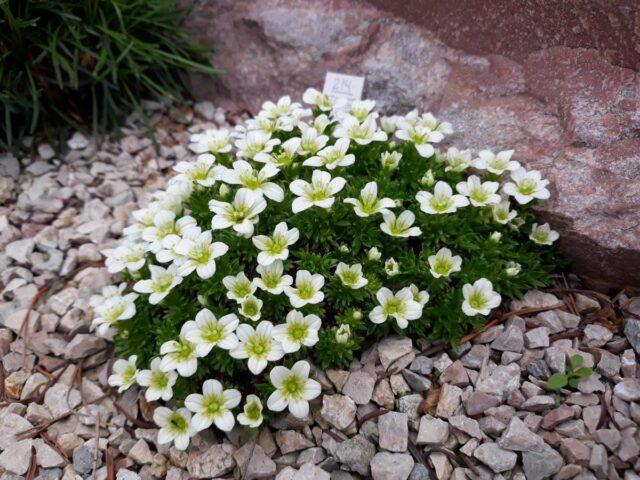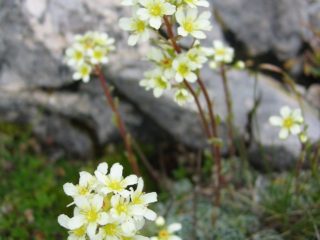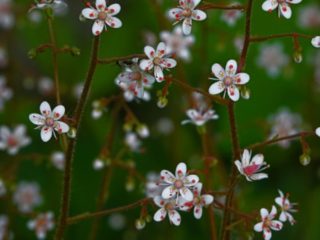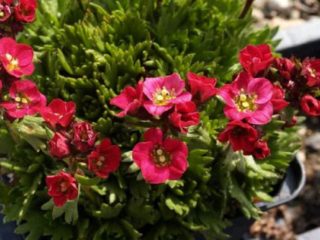Content
Saxifraga - several hundred species of one-, two-year and perennial plants, popularly called gap-grass. It can be sown in open ground with seeds or seedlings can be started first. Planting and caring for saxifrage should be carried out according to the rules after certain preparation.
Methods of propagation of saxifrage
Saxifraga can be propagated in several ways. Collecting and sowing seeds is only one of them. The material can be prepared independently after flowering.

A combination of saxifrage of different colors is effective - you can buy a mix of seeds or make your own
When planting and caring for perennial saxifrage, it can be propagated by rosettes, that is, by dividing the bush. This method is suitable for adult plants.Carry out the process when flowering is complete. Algorithm:
- Mark healthy bushes. They must have at least three sockets.
- Water the selected plants well.
- Carefully separate the additional sockets from the main one with a knife or a sharp garden spatula.
- Cover the cuttings of the mother plant with soil.
- Bury the separated rosettes in fertile soil. Choose a shaded place.
- Water.
- In spring, plant in open ground.
Before transplanting, rooting rosettes must be protected from the scorching sun. Regular watering and loosening is required.
After flowering, saxifrage can be propagated by cuttings. Algorithm:
- Select long side tendrils.
- Clamp them to the ground with staples.
- Cover the fixatives with soil.
- Water generously.
- Regularly moisten the soil so that the cuttings take root better.
- In autumn, mulch the ground, sprinkle the cuttings with leaves, sawdust or cover them with spruce branches.
- In the spring, separate the rooted shoots and replant them in a permanent place.
You can take cuttings and root them in a box. For the winter, it is better to place them in a cool room in the house. Saxifraga is transplanted in the spring.
Reproduction by cuttings or dividing the bush should be done not only for the sake of obtaining new plants. This also allows you to renew perennials that lose their decorative effect over time. The reason is excessive growth of stems and loss of leaves close to the ground.
Features of growing saxifrage from seeds
When growing saxifrage from seeds, several factors should be taken into account:
- The plant needs good drainage. This is important both when planting in open ground and when growing seedlings.
- The seeds are very small, so before sowing it is better to mix them with five parts of calcined river sand. This measure allows you to avoid excessive thickening of seedlings.
- Every 5-6 years, saxifrage needs to be replanted. This process can be combined well with updating the bushes.

Saxifraga is popular in landscape design, as it blooms all summer and forms a beautiful continuous covering.
When can you sow saxifrage?
You can sow saxifrage in open ground or with seedlings in spring or autumn. When buying seeds in a store, you should focus on the recommendations for a specific type and variety.
Planting saxifrage in autumn
Saxifraga seeds can be planted in open ground in late autumn. This option is attractive because the material will undergo natural stratification. As a result, seedlings will emerge in spring, and the likelihood of flowering in the first year will increase.
Sowing saxifrage in spring
If you first grow seedlings, it is better to sow in early February. Move plants into open ground until July. In this case, they will have time to gain strength before the fall in order to successfully overwinter.
Planting saxifrage seeds for seedlings
Growing saxifrage from seeds is easy. It is necessary to properly prepare the soil, containers and planting material, and sow it correctly.
Preparing containers and soil
You can buy ready-made soil for seedlings or make a mixture yourself. The following components are taken in a ratio of 1:5:10:20:
- lime (can be replaced with chalk);
- vermiculite;
- sand;
- peat land.
For growing seedlings, you can choose different containers - plastic containers, small boxes, cups. It is important to organize drainage holes, since plants do not like stagnant moisture. The size of containers should be oriented towards a specific variety.
At first, seedlings can be grown in one box or large container, then picking will be required. Individual containers are filled with a mixture of peat and sand.
There is another option - to plant saxifrage seedlings in peat tablets.
Seed preparation
Saxifraga seeds require stratification before sowing for seedlings. After this treatment, seedlings appear faster, plants become stronger and more resilient. Algorithm:
- Place the seeds in a shallow container.
- Apply a thin layer of wet sand.
- Seal the container with a transparent lid.
- Place the container in the refrigerator for three weeks.
For convenience, seed stratification can be done directly in the seedling container. It needs to be filled with soil, and planting material should be spread on top in a thin layer. After stratification is completed, move the container to a bright place at a temperature of 18-20 °C.
How to sow saxifrage
After stratification, the seeds can be sown:
- Fill seedling containers with moist soil mixture.
- Spread the seeds on the surface.
- There is no need to cover the crops with soil.
Cover the container with the planted saxifrage seeds with film, glass or a transparent lid and place it on a light windowsill. The optimal temperature for germination is 18-20 °C.

Seed germination takes 1-3 weeks - the period depends on the variety and quality of the seed
No watering is needed until seedlings emerge. Daily ventilation and removal of condensate are required.
Caring for saxifrage seedlings
When growing saxifrage from seeds at home, seedlings need some care. When shoots appear, the shelter must be removed. This is done gradually so that the flower gets used to fresh air. The rest of the events are:
- Water the seedlings with warm water. Focus on the condition of the soil, moisten it moderately.
- At the two-leaf stage, plant seedlings into individual containers.
- Shade plants from direct sunlight.
How to plant saxifrage in the ground
You can plant saxifrage in the ground directly with seeds or seedlings. Each case has its own characteristics.
Deadlines
You can plant strengthened and mature seedlings in the ground in May or early June. The timing is based on the growth rate of the bushes and weather conditions.
Direct sowing of seeds into the ground can be done in April-May. The soil should warm up to 8-9 °C. This option is recommended in the southern regions. In cooler climates, it is better to start seedlings first.
Site selection and preparation
Saxifraga is quite unpretentious, but still some factors are important for its good development and decorativeness. The site for the plant must meet the following requirements:
- the place is bright, but protected from direct sunlight at midday;
- no moisture stagnation;
- the soil is fertile, moderately moist and light.
Saxifraga can also grow in direct sun.If there is too much light, the leaves can become significantly lighter and there is a risk of burns, which can be expressed as dark spots. Insufficient lighting can slow growth and stop flowering.
Saxifraga feels good in a soil mixture of equal parts of sand, turf and humus. It is effective to add lime, peat, gravel. The selected area must be thoroughly loosened and removed from large roots.

Saxifraga feels good among stones and on sloping areas
Planting saxifrage seeds in open ground
When direct sowing in open ground, stratification is not necessary. Its seeds will pass naturally. The further algorithm of work is as follows:
- Prepare the area.
- Distribute the seeds over the loosened soil.
- Press the material tightly onto the soil or sprinkle it thinly with moistened sand.
After sowing the seeds, the bed can be covered with film. It will prevent moisture from evaporating quickly and will maintain the optimal temperature.
When the sprouts have three true leaves, you need to thin out the plantings, leaving the strongest specimens. Before this, abundant watering is recommended.

Many types of saxifrage grow well, forming a flower carpet - you can leave free space for this in advance
Landing algorithm
Transplanting saxifrage seedlings into open ground is not difficult. The algorithm is like this:
- Prepare the area.
- Water the seedlings generously a few days before transplanting.
- Carefully remove the bushes from the containers, keeping the earthen lump.
- Plant the plants at intervals of 10-20 cm.
Features of care
After moving seedlings into the ground or planting saxifrage with seeds, care should be comprehensive.In general, the plant is unpretentious.
Watering and fertilizing schedule
Saxifraga needs to be watered regularly, but in moderation. Moisturizing is required when the top layer of soil dries out. Watering should be done early in the morning or after sunset. The water should be warm and settled.
On cool days, plants need to be moistened less. In hot weather, the frequency of watering is increased.

Watering saxifrage during the day can cause burns to leaves and flowers.
It is recommended to feed saxifrage every month. The plant does not need fertilizers only in October-February. They should be applied for the first time three weeks after planting.
The flower responds well to mineral compositions. Dosages per 1 m²:
- 15-20 g potassium
- 30-40 g phosphorus;
- 30-40 g of ammonium sulfate, no need to add in summer;
- 25-30 g of ammonium nitrate, use only in spring and autumn.
If you use liquid concentrates, then you need to dilute them twice as much as according to the instructions. Fertilizing should be combined with watering.
Loosening, mulching
The area with saxifrage needs to be weeded regularly. Loosening is recommended after each watering or heavy rainfall. The need for this procedure and moistening can be reduced by mulching. It is good to use straw for this. The material must be spread out in a 5-centimeter layer and updated regularly.
Care during the flowering period
During flowering, it is important not to forget about standard care measures - watering, weeding, loosening. To maintain decorativeness, you should regularly get rid of dried leaves and flower stalks.
Wintering
Preparing saxifrage for winter is not difficult. Main events:
- Stop watering and fertilizing.
- Trim off the above-ground parts.
Saxifraga is a frost-resistant plant, so it requires shelter only in cold regions. It is effective to use spruce branches or leaves for this (layer 10 cm).
Diseases and pests
Saxifraga has good immunity, but this does not provide an absolute guarantee of the absence of diseases and pests. Often they are caused by improper plant care or unfavorable climatic conditions.
One of the problems is powdery mildew. This is a fungal disease provoked by high humidity, excess nitrogen, and strong thickening of plantings. It is expressed by a white coating of mycelium on the leaves. When the spores mature, droplets of liquid appear. The affected parts of the plant turn brown and fall off.
There are several methods to combat saxifrage powdery mildew:
- fungicide preparations – Topaz, Fundazol, Fitosporin, Alirin-B, colloidal sulfur, copper sulfate;
- folk remedies - whey, iodine, potassium permanganate, onion peel infusion.

To prevent powdery mildew, it is necessary to destroy the affected residues and use potassium-phosphorus fertilizers
Another fungal disease is rust. It appears as pads on the leaves, from which orange powder spills out after cracking. These are fungal spores.
Leaves affected by rust dry out and fall off, and the plant’s immunity decreases. You need to fight the disease with fungicides: Topaz, Fitosporin-M, Baktofit, colloidal sulfur, Bordeaux mixture.
To prevent rust, you need to burn plant residues, water the saxifrage moderately, and do not overfeed it with nitrogen.

Rust affects all above-ground parts of the plant and can destroy it.
With excessive watering and poor drainage, saxifrage can suffer from root rot. At the same time, the above-ground parts of the plant wither, the flowers fall off, and the entire bush gradually dies. For treatment, fungicides are used - Alirin-B, Diskor, Glyokladin.

Root rot is transmitted through soil and various equipment - sterilization is necessary for prevention
Among the pests, saxifrage can be affected by the mealybug. The size of the insect is only 5-10 mm.
Mealybug attacks the above-ground parts of the plant. The sign is a white cotton wool-like waxy coating. You can remove it with a cotton swab dipped in soapy water. Then spraying is needed:
- drugs – Aktara, Fitoverm, Biotlin, Tanrek;
- folk remedies - infusion of garlic or tobacco, decoction of cyclamen.

To prevent mealybugs, it is necessary to promptly remove dried leaves.
Saxifraga can be affected by aphids that feed on plant juices. At the same time, the flower begins to dry and wither and slowly dies. There are many ways to combat the pest:
- drugs – Tornado, Tanrek, Biotlin, Aktara, Apache;
- sticky traps;
- folk remedies - solutions of garlic, onion, tobacco, chamomile, potato tops
- plants that repel aphids with a strong smell - garlic, fennel, mint, coriander, basil, marigolds.

The color of aphids depends on its type and can be black, red, green, brown, yellow
Another enemy of saxifrage is the spider mite. It is difficult to see, but can be identified by a thin cobweb on the undersides of the leaves, white dots, and causeless drying.To combat ticks, the drugs Fufanon, Kleschevit, Fitoverm, Bitoxibacillin, and Iskra Bio are used.

The size of a spider mite is less than 1 mm; the pest is not dangerous for people, animals and birds
Conclusion
Even inexperienced gardeners can plant and care for saxifrage. It can be sown with seeds in open ground or grown through seedlings. The flower is unpretentious and has good immunity. The variety of species and varieties ensures its wide application in landscape design.








